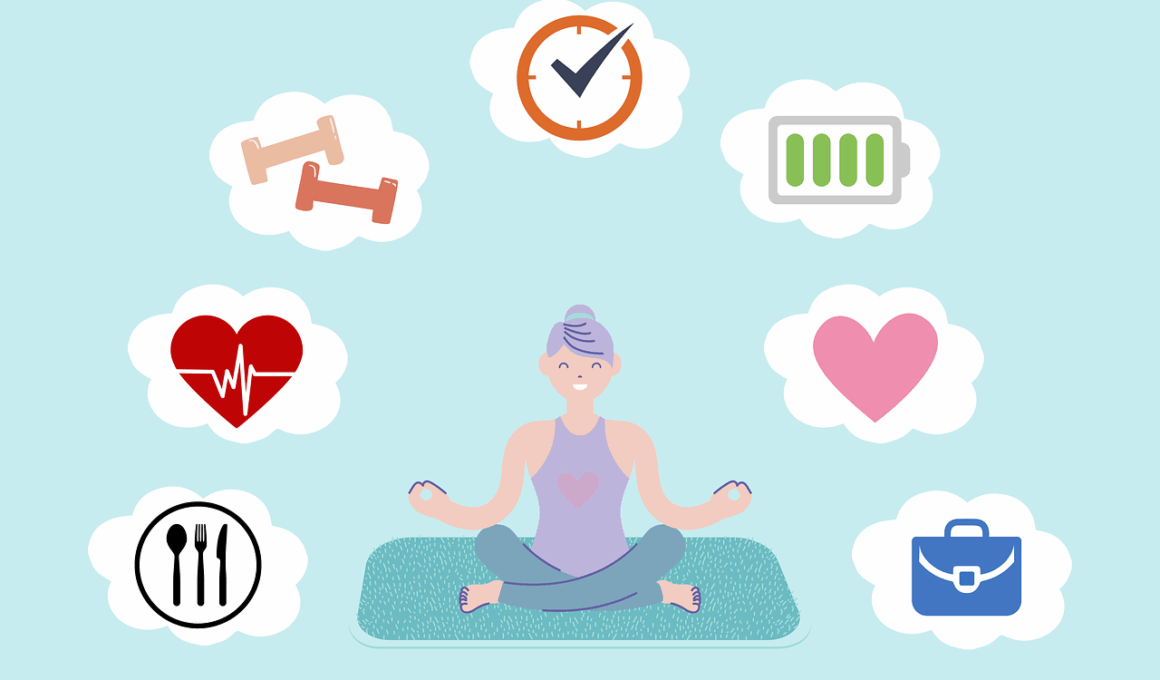Techniques for Staying Mentally Present During Swimming Workouts
Maintaining mental presence during swimming workouts is essential for performance and enjoyment. One of the best techniques is to focus on your breathing patterns. By inhaling and exhaling rhythmically, swimmers can establish a mindful state. Try counting your strokes while synchronizing your breath with the strokes. This dual focus can significantly enhance concentration and present awareness. The next effective approach is visualization. Imagining your perfect swim can create a positive mental state. Picture the water flowing smoothly, and visualize your body moving effortlessly. This mental imagery can help you stay connected to the physical experience, leading to better execution. You might also want to practice mindfulness techniques like body scanning or progressive muscle relaxation. This practice can increase awareness of your bodily sensations while swimming, ensuring you stay engaged. Listening to music has its advantages, too. You may choose rhythmic tunes that align with your strokes or calming sounds that keep your mind at ease. Each of these techniques can transform your swimming workouts, enabling a greater connection with the water and your body.
This paragraph discusses the importance of setting intentions. Before each workout, take a few minutes to set an intention. Decide whether you want to improve your speed or simply enjoy the moment in the water. By focusing on a strong intention during your routine, you create a mental guide that keeps you aligned with your objectives. Another important aspect is to stay present by maintaining awareness of your surroundings. Notice the sounds of water splashing, the sensations of movement, or the feeling of being submerged in water. Engaging your senses can anchor your mind in the moment, reducing distractions. Moreover, take short breaks throughout long workouts. Use these pauses to recalibrate your focus and mentally reaffirm your intention. Swim practices can also incorporate goal-oriented drills; each lap can have a specific aim, such as improving efficiency. Incorporating visual markers on the pool deck can provide cues to remind you to stay focused. Trying a mantra, perhaps a simple phrase like “breathe and swim,” can gently bring your thoughts back to your practice.
Staying Connected with the Water Environment
Every swimmer must recognize the transformative power of being connected to their environment. The water can offer inherent stillness and peace that is beneficial as you swim. Practice engaging with the temperature, texture, and movement of the water around you. Notice how it feels against your skin. This physical connection can serve as an anchor, drawing your attention back to the present moment when you feel distracted. Pay attention to how the water’s dynamics affect your stroke. Subtle changes can help tightness or tension in your muscles ease away gradually. Focusing on your connection with the water can also enhance performance, as a more engaged mindset typically leads to improved movements. Sound is pivotal in this experience; listen to the rhythm of your strokes or the gurgling of the water. These auditory signals help stay grounded in your practice. Moreover, practicing nature-focused swims outdoors can foster a stronger bond between you and your environment. Notice the light, plants, or aquatic creatures around you, which can contribute to a holistic approach to swimming’s mental aspects.
Incorporating meditation techniques into your swimming practice can be incredibly rewarding. Experiment with different forms of meditation, such as mindfulness meditation or loving-kindness meditation, before entering the pool. Spend a few minutes visualizing your swim while focusing inward. This mindfulness practice ensures mental clarity and enhances your ability to stay present during the actual workout. As you swim, channel that peaceful energy by continuing to bring thoughts back to your breath and strokes. You can even practice in-water meditation, where you perform gentle strokes while maintaining a continuous sense of calm and focus. The integration of meditation cultivates a strong sense of self-awareness, allowing you to connect deeper with your motions. Prioritizing this mental state fosters a more enjoyable experience as you embark on your training. Yoga-inspired stretches may also be beneficial during warm-ups before swims. Incorporating balance and control techniques can improve your body awareness and help you remain mentally aligned. These approaches create a solid foundation that benefits both performance and enjoyment during your swimming routine.
The Role of Positive Self-Talk
Maintaining a strong, positive inner dialogue can enhance mental presence, particularly during swimming sessions. Negative thoughts can infiltrate your mind, creating unnecessary distractions. To combat this, develop positive self-talk affirmations to encourage yourself as you swim. Use phrases like “I am strong and capable” or “I enjoy the rhythmic flow of swimming.” These affirmations can cultivate a sense of confidence and motivation that sustains focus during your workout. Moreover, diving into constructive comparisons rather than negative ones can help maintain presence. Focus on your improvements instead of scrutinizing perceived flaws. Comparing your current performance with previous workouts allows for appreciation of the journey. Journaling after practices can also reinforce positive feelings by documenting your accomplishments. By writing down thoughts or feelings about your swim, you can reflect on progress, improving your mindset. Remember, your mental attitude directly influences your physical capabilities while swimming. When you shift focus from self-doubt to empowerment, the training becomes a much more fulfilling experience, and you begin to realize your full potential.
Regular feedback is another essential aspect of maintaining mental presence during swimming workouts. Request critique and support from coaches, training buddies, or self-assess through recordings. Engaging with constructive feedback allows an opportunity for growth while focusing on specific areas that require attention. Emphasizing personal accountability enhances motivation and clarity in your training routine. Visualization plays a crucial role here, as you can picture success while integrating feedback. If you overhear a piece of advice from a coach, visualize that technique while you swim, assisting in your mental presence. Another useful tool is to maintain a swimming log detailing your achievements, feelings, and challenges. This reflective practice strengthens awareness of your mental journey and progresses. Consider setting specific milestones for motivation to maintain focus and direction. Having defined goals gives a sense of purpose in each workout, preventing wandering thoughts. Be adaptive; as you achieve one milestone, set another to ensure a continuous drive for improvement. This consistent review can create a proactive mental approach, allowing you to stay present and engaged in the moment.
Conclusion: Embracing Mindfulness Techniques
Implementing these techniques for staying mentally present during swimming workouts can dramatically enhance your experience. Remember to employ breathing exercises, visualization, mindfulness practices, and positive self-talk to maintain focus. Set intentions and stay connected to the water environment to achieve a holistic approach. Slow down, breathe deeply, and appreciate your journey in the water. Each swim should become a mindful practice, incorporating peace and enjoyment into your exercise routine. As you hone your skills by actively engaging with these techniques, you will notice improvements in both your mental and physical abilities. Watch as your confidence grows, transforming each training session into a fulfilling adventure. Utilize feedback, reflective writing, and meditative elements to support your journey. Do not forget the importance of patience; recognize that mastering mental presence takes time. Each step taken in understanding your mental landscape will lead to a more rewarding experience while swimming. Embrace the process, relish the gradual improvements, and enjoy the meditative state that swimming brings. In due course, you will find contentment and presence both inside and outside the pool.


